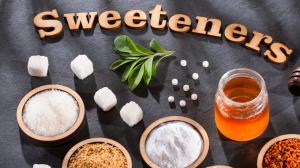Novel Sweeteners Market Set to Reach USD 2.15 Billion by 2035 Amid Soaring Demand for Health-Conscious Sugar Alternative
The Novel Sweeteners Market is witnessing steady growth driven by rising health awareness and demand for low-calorie sugar alternatives.
Innovative sweeteners such as stevia, monk fruit, allulose, and rare sugars are gaining rapid popularity as healthier alternatives to traditional refined sugar and synthetic sweeteners. Consumers are growing more health-conscious, motivated by concerns about obesity, diabetes, and other metabolic disorders. As a result, there’s a marked preference for sweeteners that are natural, functional, and low in calories—delivering sweetness without compromising on health.
Stay Informed – Request a Sample Copy for Exclusive Insights: https://www.futuremarketinsights.com/reports/sample/rep-gb-17786
Health-Conscious Consumers Propel Demand for Natural Sweeteners
As health-conscious consumers increasingly seek low-sugar and low-glycemic index sweeteners, the food and beverage industry is witnessing a sharp pivot toward plant-based sweeteners such as stevia and monk fruit. These zero-calorie sweeteners have gained popularity not only for their natural origin but also for their ability to maintain sweetness without spiking blood sugar levels, making them ideal for diabetic-friendly foods and nutraceutical sweetening agents.
In addition to individual health concerns, the global rise in lifestyle diseases such as obesity and type 2 diabetes is encouraging consumers and manufacturers alike to adopt sugar reduction strategies. This trend has significantly increased the usage of non-nutritive sweeteners across diverse applications, including functional food and beverage reformulation.
Clean Label and Sustainable Trends Encourage Ingredient Transparency
The global clean label movement has had a profound impact on the novel sweeteners market, with manufacturers reformulating products to align with consumer expectations for transparency, simplicity, and natural origins. As part of these clean label food ingredient initiatives, companies are replacing artificial sugar substitutes with sustainable sweetener sources, such as agave, erythritol, and allulose.
Consumers are now actively seeking innovative sweetening solutions that align with ethical sourcing, sustainability, and minimal processing. This has propelled demand for novel sweeteners in categories like plant-based dairy, baked goods, and ready-to-drink beverages.
Food Manufacturers Shift to Sugar Alternatives for Product Reformulation
The shift towards sugar alternatives is not merely a consumer-driven trend but a strategic priority for food producers. With global regulations imposing limits on added sugars, food manufacturers are reformulating their products to maintain taste and functionality while complying with health standards.
These efforts are particularly notable in the snack, beverage, and confectionery industries, where maintaining the sensory profile of products without refined sugar is critical. The increasing integration of functional ingredients in food—especially novel sweeteners—is central to this transformation.
Functional Food Market and Nutraceuticals Fuel Market Expansion
The functional food market is a major driver of novel sweetener consumption. As consumers look for food that provides both nutritional and therapeutic benefits, manufacturers are innovating with reduced sugar product innovation that doesn’t compromise on health benefits.
In particular, nutraceutical sweetening agents are gaining traction in sports nutrition, dietary supplements, and wellness beverages. These sectors are leveraging natural low-calorie sweeteners to deliver health-supporting products with great taste and added functionality.
Health-Conscious Consumers Propel Demand for Natural Sweeteners
As health-conscious consumers increasingly seek low-sugar and low-glycemic index sweeteners, the food and beverage industry is witnessing a sharp pivot toward plant-based sweeteners such as stevia and monk fruit. These zero-calorie sweeteners have gained popularity not only for their natural origin but also for their ability to maintain sweetness without spiking blood sugar levels, making them ideal for diabetic-friendly foods and nutraceutical sweetening agents.
In addition to individual health concerns, the global rise in lifestyle diseases such as obesity and type 2 diabetes is encouraging consumers and manufacturers alike to adopt sugar reduction strategies. This trend has significantly increased the usage of non-nutritive sweeteners across diverse applications, including functional food and beverage reformulation.
Clean Label and Sustainable Trends Encourage Ingredient Transparency
The global clean label movement has had a profound impact on the novel sweeteners market, with manufacturers reformulating products to align with consumer expectations for transparency, simplicity, and natural origins. As part of these clean label food ingredient initiatives, companies are replacing artificial sugar substitutes with sustainable sweetener sources, such as agave, erythritol, and allulose.
Consumers are now actively seeking innovative sweetening solutions that align with ethical sourcing, sustainability, and minimal processing. This has propelled demand for novel sweeteners in categories like plant-based dairy, baked goods, and ready-to-drink beverages.
Food Manufacturers Shift to Sugar Alternatives for Product Reformulation
The shift towards sugar alternatives is not merely a consumer-driven trend but a strategic priority for food producers. With global regulations imposing limits on added sugars, food manufacturers are reformulating their products to maintain taste and functionality while complying with health standards.
These efforts are particularly notable in the snack, beverage, and confectionery industries, where maintaining the sensory profile of products without refined sugar is critical. The increasing integration of functional ingredients in food—especially novel sweeteners—is central to this transformation.
Functional Food Market and Nutraceuticals Fuel Market Expansion
The functional food market is a major driver of novel sweetener consumption. As consumers look for food that provides both nutritional and therapeutic benefits, manufacturers are innovating with reduced sugar product innovation that doesn’t compromise on health benefits.
In particular, nutraceutical sweetening agents are gaining traction in sports nutrition, dietary supplements, and wellness beverages. These sectors are leveraging natural low-calorie sweeteners to deliver health-supporting products with great taste and added functionality.
Your Competitive Advantage Starts Here – Access Full Report: https://www.futuremarketinsights.com/reports/novel-sweeteners-market
Mark Farias Releases New Album Gasoline Milkshake
Rental Supply Inc. Recognized Among Fastest-Growing Equipment Rental Companies in North America
Prept Bridges Boutique Style and Tech to Elevate & Personalize The Shopping Experience
Kalendarium
Więcej ważnych informacji
 Jedynka Newserii
Jedynka Newserii

 Jedynka Newserii
Jedynka Newserii

Handel

Ze względu na różnice w cenach surowce wtórne przegrywają z pierwotnymi. To powoduje problemy branży recyklingowej
Rozporządzenie PPWR stawia ambitne cele w zakresie wykorzystania recyklatów w poszczególnych rodzajach opakowań. To będzie oznaczało wzrost popytu na materiały wtórne pochodzące z recyklingu. Obecnie problemy branży recyklingu mogą spowodować, że popyt będzie zaspokajany głównie przez import. Dziś do dobrowolnego wykorzystania recyklatów nie zachęcają przede wszystkim ceny – surowiec pierwotny można kupić taniej niż ten z recyklingu.
Przemysł spożywczy
Rośnie presja konkurencyjna na unijne rolnictwo. Bez rekompensat sytuacja rolników może się pogarszać

Rolnictwo i żywność, w tym rybołówstwo, są sektorami strategicznymi dla UE. System rolno-spożywczy, oparty na jednolitym rynku europejskim, wytwarza ponad 900 mld euro wartości dodanej. Jego konkurencyjność stoi jednak przed wieloma wyzwaniami – to przede wszystkim eksport z Ukrainy i niedługo także z krajów Mercosur, a także presja związana z oczekiwaniami konsumentów i Zielonym Ładem. Bez rekompensat rolnikom może być trudno tym wyzwaniom sprostać.
Transport
Infrastruktury ładowania elektryków przybywa w szybkim tempie. Inwestorzy jednak napotykają szereg barier

Liczba punktów ładowania samochodów elektrycznych wynosi dziś ok. 10 tys., a tempo wzrostu wynosi ok. 50 proc. r/r. Dynamika ta przez wiele miesięcy była wyższa niż wyniki samego rynku samochodów elektrycznych, na które w poprzednim roku wpływało zawieszenie rządowych dopłat do zakupu elektryka. Pierwszy kwartał br. zamknął się 22-proc. wzrostem liczby rejestracji w ujęciu rocznym, ale kwiecień przyniósł już wyraźne odbicie – o 100 proc.
Partner serwisu
Szkolenia

Akademia Newserii
Akademia Newserii to projekt, w ramach którego najlepsi polscy dziennikarze biznesowi, giełdowi oraz lifestylowi, a także szkoleniowcy z wieloletnim doświadczeniem dzielą się swoją wiedzą nt. pracy z mediami.









.gif)

 |
| |
| |
|